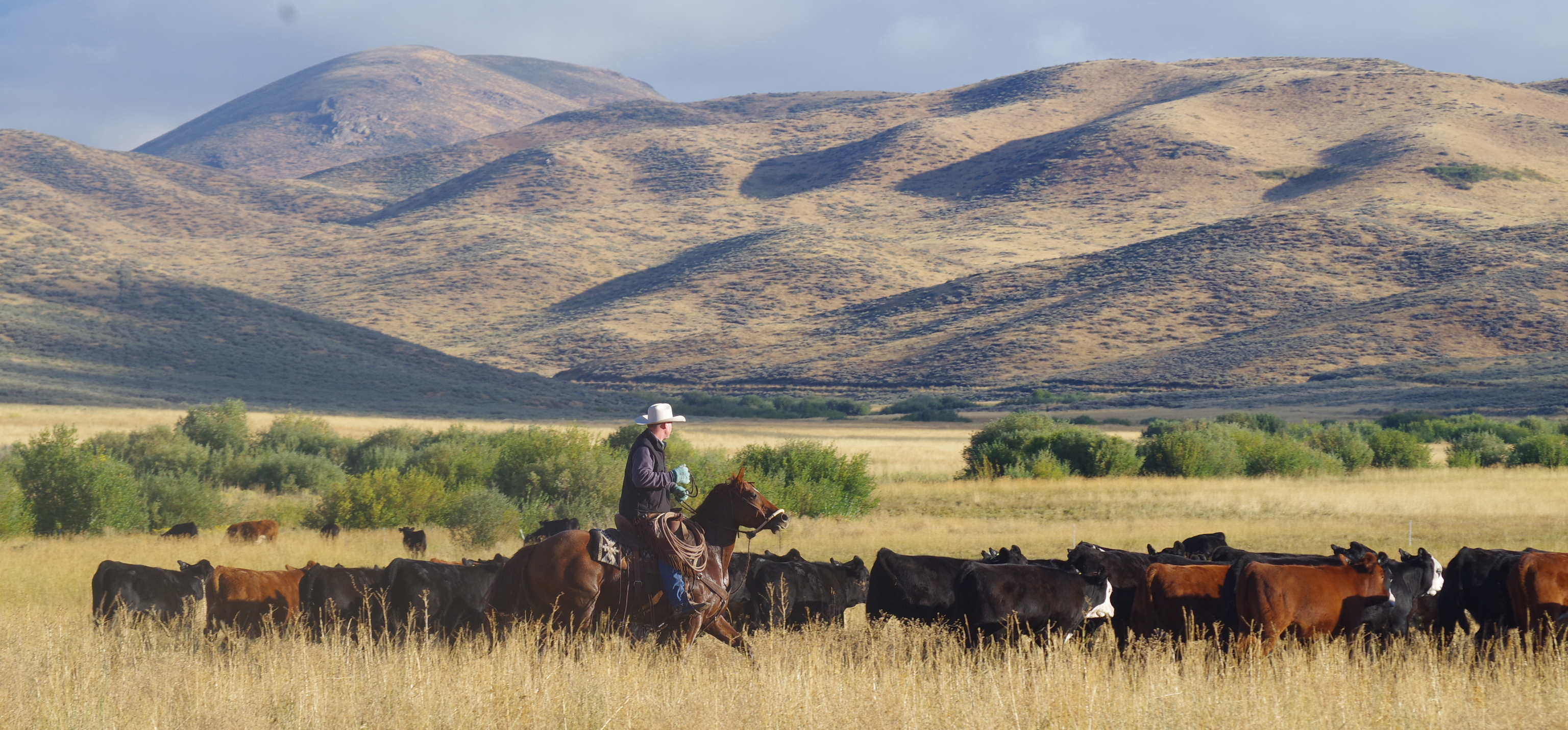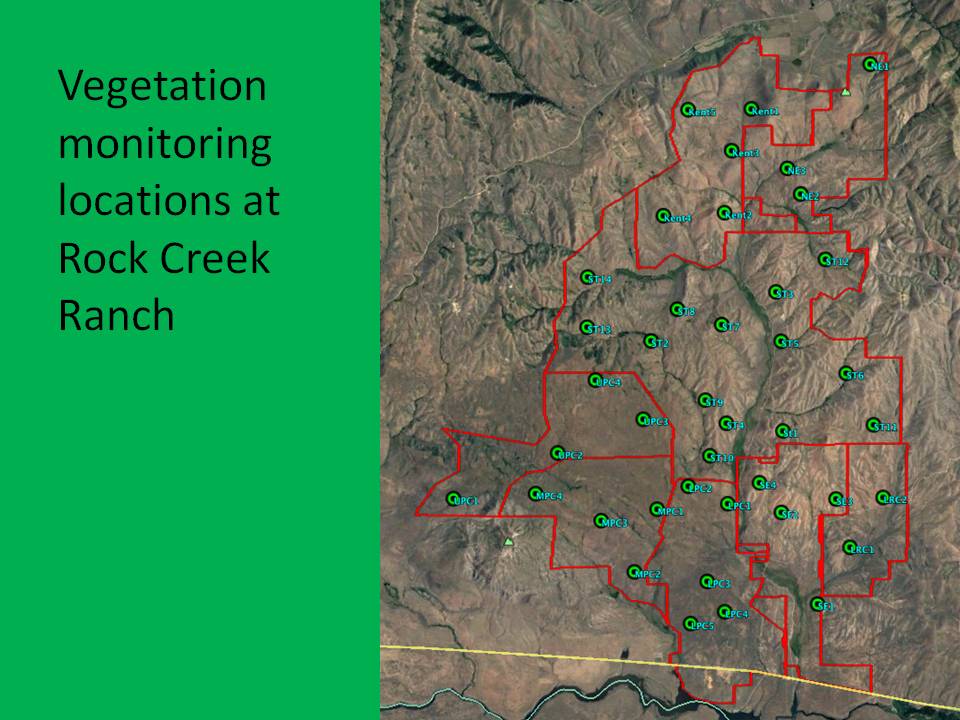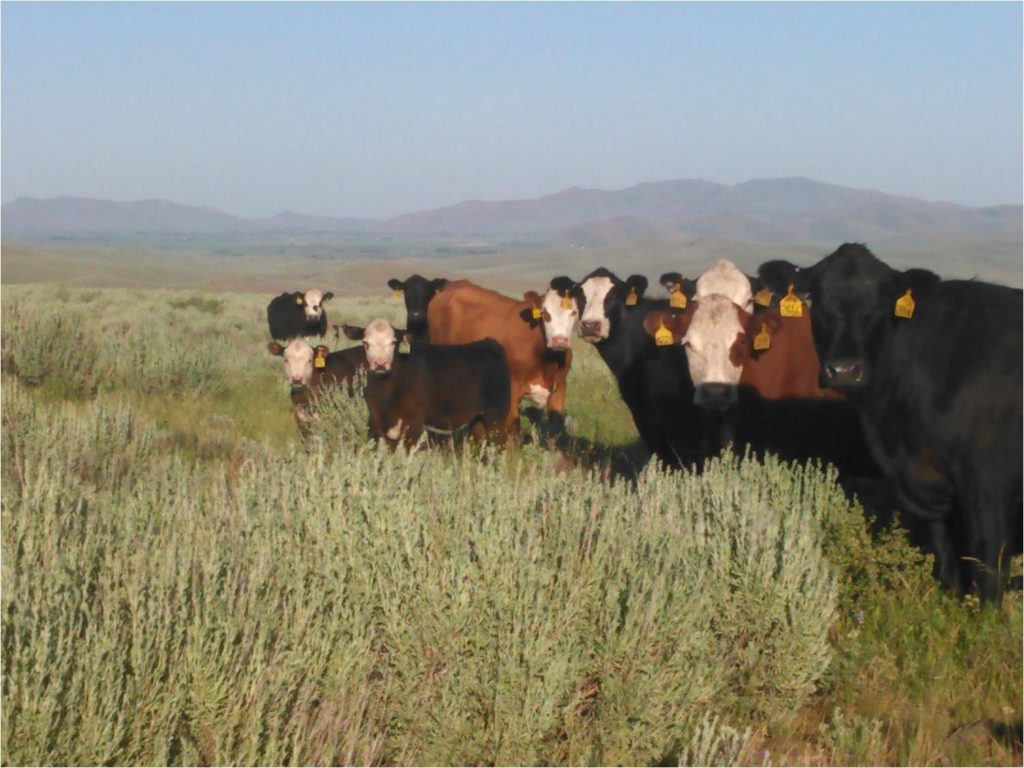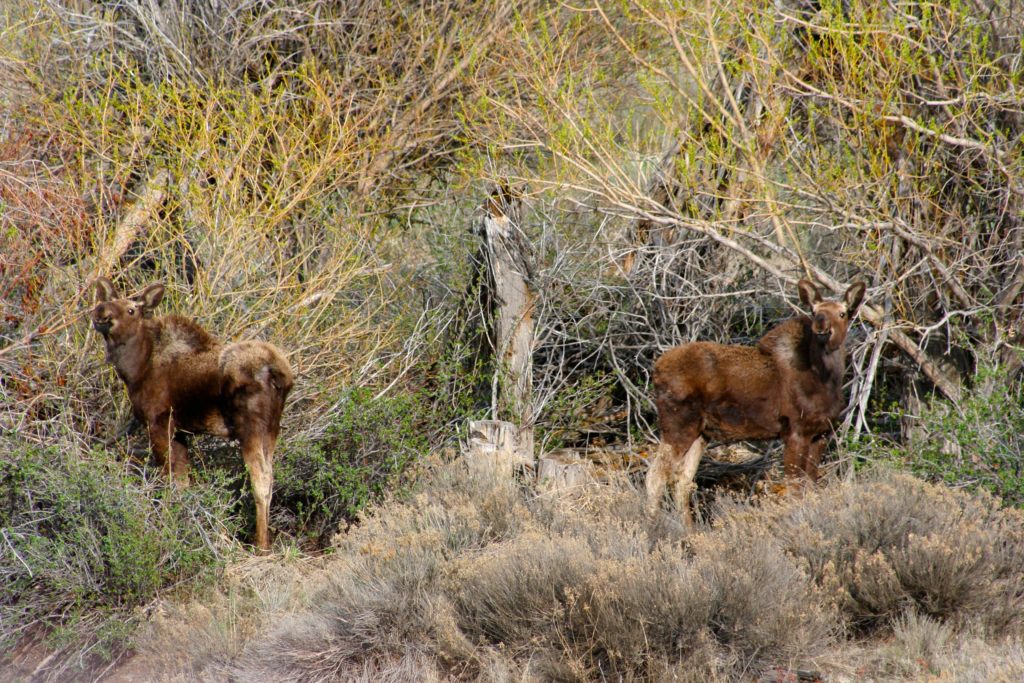Rock Creek Ranch embraces 10,400 acres of land in a series of succulent meadows surrounded by miles upon miles of good-quality rangeland below the shadow of the Smoky Mountains in Blaine County.
The ranch is home to sage grouse, a species of concern, as well as moose, elk, deer, antelope and other critters.
Because of its dual qualities as a working ranch with strong conservation values, Rock Creek Ranch was purchased recently from the Rinker Family by the Wood River Land Trust and The Nature Conservancy in a unique partnership with the University of Idaho.

Wyatt Prescott herds cattle on a sunny morning at Rock Creek Ranch.
Under the partnership, the University of Idaho provides a cow-calf cattle herd from its Nancy M. Cummings Research, Extension and Education Center in Salmon for rangeland-related research. The 850-acre Cummings Ranch is all irrigated pasture. Rock Creek offers an opportunity to do research on a ranch with a true rangeland setting.
“It’s a great station, we can do a lot of great research here, but one of the things we’ve always lacked has been a range component,” says John Hall, Superintendent of the Nancy M. Cummings Research, Extension and Education Center in Salmon. “That means our system of production was not really relevant to the majority of the industry, which relies on range at least 5-6 months out of the year. So the Rock Creek Ranch gave us a wonderful opportunity to expand our research, and make our research more industry-relevant.”
Both the Wood River Land Trust and The Nature Conservancy are excited about the potential to do research and education at the ranch through the partnership with the University of Idaho and the UI Rangeland Center.
“A great part about this project is the research that’s taking place here, and we don’t have that on many of our projects,” said Lou Lunte, deputy director of The Nature Conservancy in Idaho. “So being able to partner with the U of Idaho. The Nature Conservancy prides itself on using science to guide our conservation work. So actually having a ranch, working with the university, we could do really good research, which is important us.”

“Sagebrush Saturdays” education events offer an opportunity for the public to learn about rangelands, plants, wildllife, cattle management and more at Rock Creek Ranch.
Public education programs at the ranch like “Sagebrush Saturdays” also provide a window into the benefits of good stewardship.
There were five education events in the first summer of ranch operations. Topics included learning about birds of prey, wildflowers and pollinators, beavers, bugs and stream restoration, soil, fire and wildlife, and raising cattle from A-Z.
Rock Creek Ranch also hosted the Western National Rangeland Career Day Event for high school students learning about range management. Students from multiple western states participate. During a full day in the field, they worked on things like plant identification, evaluating habitat for wildlife and livestock, and making recommendations for future management.
Scott Boettger, executive director of the Wood River Land Trust, is excited about the educational opportunities at the ranch.
“Like the Peaveys have been able to do that with the Trailing of the Sheep, there’s a big component of that, understand what it means to have cattle on that land in a way that benefits the grass regrowth, the fire prevention, all of the things that aren’t understood at first blush,” he said. “More importantly, get good information out there, what it actually means to graze it properly, and how that’s a healthier situation for all.”
Karen Launchbaugh, Director of the University of Idaho Rangeland Center, describes the new collaborative research opportunities at Rock Creek.
“Well, it’s really a brand new idea, it came out of efforts that really came together, it’s a mix of people’s ideas of what should be done on landscapes, and the science and education there to see if it works,” she says. “To me, that’s what really unique about it, is this combination of science and education, and a lot of voices weighing into that and helping us how to do this at a landscape scale. Brand new idea.”
It might have been serendipity that the Wood River Land Trust worked with the Rinker family and partnered with the Nature Conservancy to save the ranch for conservation purposes.
At one time, the Rinkers were looking at building a subdivision there, with up to 2,000 residential units, west of Hailey. But that idea didn’t bode well with locals in Blaine County.
“The initial intent was it could become a development play, where it would become an off-shoot of Hailey, and actually the formation of its own city, but there was a lot of obstacles involved with that, it had no power, as such that would have been a huge cost and impact to the land,” explains Bart Rinker. “The political environment started to change to the point where doing a development of that type would be questioned.”

Harry Rinker was willing to look at a conservation outcome for Rock Creek Ranch after finding success as a developer in Blaine County and California.
The Rinkers decided to withdraw their development proposal and focused on selling the ranch. Along the way, ranch broker Trent Jones, who also is a board member on the Wood River Land Trust, started to discuss the possibility of a conservation outcome with the Rinker Family.
“Maybe there’s a way to generate some funding through the Grassland Reserve Program administered by NRCS, maybe there’s some other public entities who could bring some money to the table, the Land Trust, and also looking to the Rinker family, if a conservation outcome, which could really be a legacy, after so many years here in the valley, maybe there’s something the family could contribute beyond just creating the opportunity?” Jones says.
The Rinkers were open to the concept. Bart’s dad, Harry Rinker, had been a very successful developer in California, building subdivisions, gas stations and shopping centers. Harry Rinker came to Sun Valley to vacation early on and also developed some successful housing developments in the Wood River Valley – including the Golden Eagle Ranch and Gimlet.
“And then it started into a collaborative discussion,” Bart Rinker said. “It came to light that there could be some other benefits that we could benefit from, as well as the county, the Land Trust, TNC, all of that.”
Trent Jones and Bart Rinker engaged with the Natural Resources Conservation Service (NRCS) to explore the concept of selling easements to the agency through the Grassland Reserve Program. The robust sage grouse populations and premium habitat at the ranch made it a good fit.
In the meantime, Trent Jones worked with Scott Boettger at the Wood River Land Trust to see if they could raise sufficient funds to buy the ranch. This was where The Nature Conservancy came into play.
”The magnitude of the property is significant. We’ve never come close to protecting something that large,” Boettger said. “We didn’t have anything close to the money we needed to purchase this ranch, even with the significant reduction in asking price that the Rinkers wanted.
“With the GRP easements, we were able to generate most of the monies necessary to acquire the property. So we borrowed money, in conjunction with the TNC to make it happen. They were true partners, our name was on the title, but without their support, we couldn’t have done this.”
The Nature Conservancy had its eye on the Rock Creek property for some time, explains Lou Lunte. “We have a 30- to 40-year history at Silver Creek and the Wood River Valley. But this was a big project, and the land trust was a smaller organization, so it was great that we could partner together to make it happen,” he says.
“It was a time also to reflect and give back to the valley. That was also a very, very important part of our decision,” says Bart Rinker, son of Harry Rinker.

A mix of high-quality wildlife habitat and high-quality rangelands made the Rock Creek Ranch a good fit for education and research.
And then discussions turned toward the concept of partnering with the University of Idaho to do research and education.
“And that’s really when the University of Idaho came into the conversation,” says Lou Lunte. “They have this place up in Salmon, the Cummings Research Center, which is addressing some ranching issues, but it’s an irrigation pasture setting vs. a rangeland setting. So after thinking about it, it just seemed like a perfect pairing to give the university a true rangeland setting, and help us move forward with our vision for the ranch.”
Laurie Lickley, former board president of the Idaho Cattle Association, was instrumental in persuading legislators and the University of Idaho about the partnership at Rock Creek Ranch.
Another positive aspect that occurred was that Wyatt Prescott, former executive vice president of the Idaho Cattle Association, was hired to manage cattle operations at the ranch for research and education. Prescott speaks about the ranch’s potential at a Sagebrush Saturdays event.
“That’s what we’re trying to do here, find out what the ranch personality is, and do those developments so you can use cattle as a conservation tool in a working landscape, and not just a beef production tool,” Prescott says. “My passion about this project is there’s going to be a number of research projects done out here from the university perspective, to look at how do we do that better. How do we use that livestock better as a tool for conservation?
“It’s not good enough for me as a rancher and cattle consultant to say we can serve wildlife habitat and raise a few cows, we have to strive to find production techniques that both enhance the amount of beef we can produce on this landscape, and but also enhance the amount of conservation wildlife habitat we can produce on this landscape, both.”

Part of the research at Rock Creek Ranch will look at whether livestock and wildlife can co-exist under tightly controlled management.
Management, research and education functions at Rock Creek Ranch are overseen not only by the Wood River Land Trust, The Nature Conservancy, and the University of Idaho, but also by a diverse advisory committee, including the Idaho Cattle Association, NRCS, Central Idaho Rangeland Network, Idaho Soil & Water Conservation Commission, Idaho Rangeland Resource Commission, Idaho Fish and Game, and the U.S. Fish and Wildlife Service.
The University of Idaho Rangeland Center brings together the research functions of the UI College of Agriculture and Life Sciences and the UI College of Natural Resources at Rock Creek. “Rangeland studies and education at the U of Idaho have always been done at the College of Natural Resources and the College of Agriculture, and this ranch gives us a chance to work side by side on the same project,” Launchbaugh says.
The Rock Creek Ranch deeded lands, combined with another 11,000 acres of BLM and state grazing allotments, encompass a whole watershed. Launchbaugh notes that it’s rare to do research in such an ideal setting.
“One, it’s one watershed. We don’t get that chance very often,” she says. “But that gives us a lot of understanding about management and research, so that’s unique. The location of Rock Creek is really cool because it’s right in the middle of Idaho. And then the third thing that makes it unique is the private federal and state lands, so it is a pretty good post card of what ranching looks like in Idaho.”
Given the ranch’s location near Hailey, Idaho, it’s close to population centers in southern Idaho, convenient for range tours for policy-makers, state legislators, school groups and other ranchers.
“That location is just tremendous because of its geographic location in the state,” says UI’s John Hall. “The fantastic thing is it’s two hours from Boise, it’s just a hop and a skip from Twin Falls, so we can bring up students from the College of Southern Idaho, we can bring K-12 kids up there from a variety of communities, and we can bring legislators and students over from Boise.”
“It’s not only a super resource for educating ranchers about certain grazing management techniques or aspects of public land management that we want them to consider. But we also will integrate with the public, and tell the public our story on how grazing on public lands can be a beneficial thing for the environment, the resource, and also create food for people in our country.”

Research professionals will track water quality and rangeland trends as part of ongoing research at the ranch.
In the first year of operation at the ranch, eight research projects got under way, and more are being planned. The projects cover a wide variety of topics, from animal health to invasive weeds to monitoring plants and water quality, and a study looking for the ideal range cow using space age technology.
“We’re trying to find cattle that fit these rangeland systems, but also will use rangeland sustainably and will have minimal impacts,” says Jim Sprinkle, a Ph.D. Beef Extension Specialist for the University of Idaho at the Cummings research and education facility in Salmon.
Using GPS collars and accelerometers, Sprinkle is tracking how cattle use the range, how much they eat, how much they travel, how much they rest and sleep, etc. The more efficient cows don’t need as much to eat and graze in the upland areas, where ranchers want them to graze. The less-efficient cows eat more forage each day, and tend to be lazy, staying in the creek-bottom instead of hiking to the uplands, Sprinkle says.
“We’re looking for the ideal cow.”
Mother cows with more efficient characteristics could be bred with bulls to improve the efficiency of a cow herd, Sprinkle said. “This research I’m describing to you is some of the first research of its kind in the world.”

One of the studies at Rock Creek is looking at the charateristics of “efficient” cows that eat less and hike into the uplands for forage, where ranchers want them to graze.
Another study at Rock Creek is looking at the impact of cattle grazing on wet meadow habitat where sage grouse like to raise their broods. Using electric fence, they created six, 5.5-acre pastures, and put different numbers of cattle in the pastures to consume forage and tracked the results.
They will look at various levels of grass utilization and how that might affect sage grouse broods and cattle weight gain.
All of these studies are exciting to working ranchers like Jerald Raymond, board president of the Idaho Cattle Association who ranches near Menan in Eastern Idaho.
“This ranch benefits wildlife, it benefits livestock, it benefits those alliances we have with the sportsmen, with the education, and with the communities that surround this area. The research being done will enhance what we know about how livestock reacts to certain situations and how wildlife reacts to those scenarios and situations.
“I think there’s a misperception that livestock and wildlilfe can’t co-mingle,” he continues. “They can co-mingle, and they actually complement each other. And the research being done on this facility is going to validate that. The fact that we can utilize a resource at certain times, and have that resource still be viable and enhanced for endangered species and for wildlife.”
Now that research, education and conservation are moving ahead at Rock Creek Ranch, it’s rewarding for the people involved to see things moving ahead.
“I’m just really excited about the property,” says Lou Lunte with the Nature Conservancy. “It’s a dream come true. Twenty years ago, I walked this ranch, saw how impressive it was, saw the potential then, and sometimes patience and persistence 20 years later, starting to realize that dream. Couldn’t happen without great partners. But it’s fabulous.”

The Rock Creek project is seen as a gift to Blaine County and Idaho as a whole that will have long-lasting benefits for education, research, cattle management and conservation.
Adds Trent Jones of the Wood River Land Trust, “It’s a gift to this community that’s hard to replicate and really a legacy for the Rinker family. We are all so deeply appreciative of what they’ve done toward that end.”
“I’m just so proud to be part of a bigger project,” says Boettger. “It wouldn’t be possible without all of the different partners being involved. And the future of that property is much grander than we ever could have imagined. The university brings a big part of that, and I’m really excited about the future.”
Steve Stuebner is the writer and producer of the Life on the Range online education series, sponsored by the Idaho Rangeland Resources Commission.
© Idaho Rangeland Resources Commission 2018

